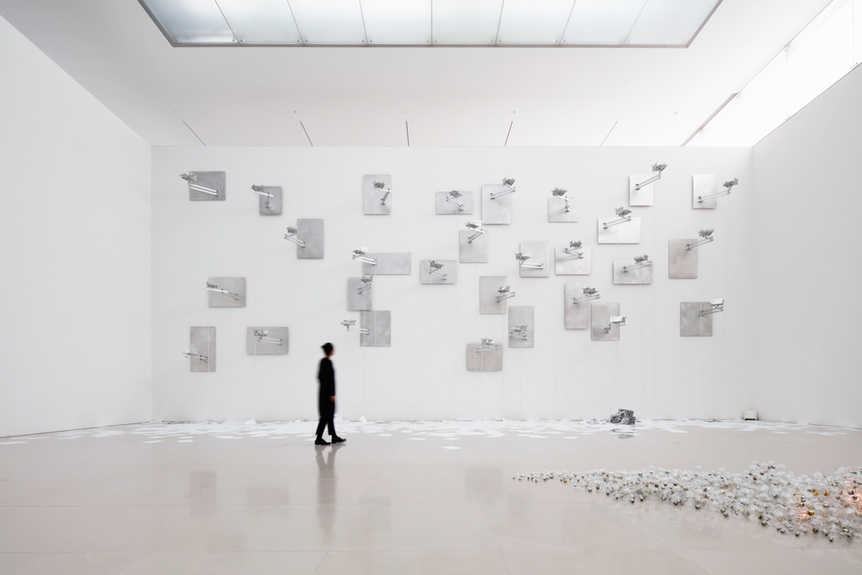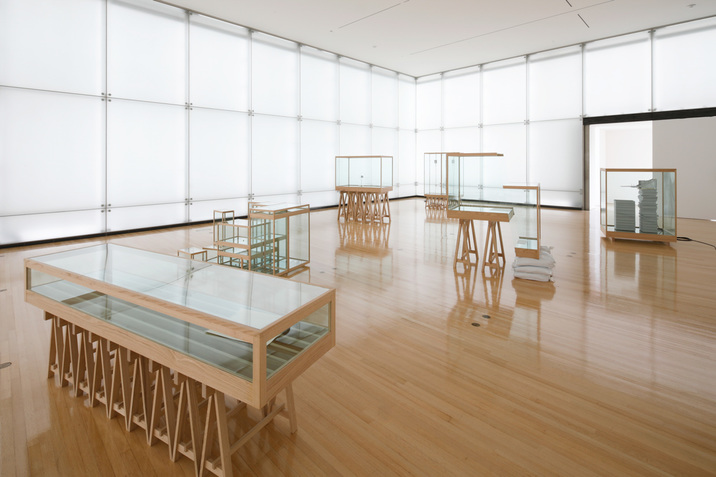-
From Current Issue
-
- Editor’s Letter Fire in the Heart
- Reviews I Gusti Ayu Kadek Murniasih
- Reviews 11th Seoul Mediacity Biennale: “One Escape at a Time”
- Dispatch Networked China
- One on One Monira Al Qadiri on Yukio Mishima
- Essays The rise of independent art spaces in pandemic-era Shanghai
- Features Tuan Andrew Nguyen
- Table of Contents
- Web Exclusives
- Archive
- Subscribe

R
E
V N
E
X
T
Detailed installation view of TSUYOSHI HISAKADO’s A polite existence, 2020, paper, clock, brass, wood, mechanical pencil lead, battery, chestnut, acrylic and others, dimensions variable, at “Practice of Spiral,” Toyota Municipal Museum of Art. Photo by Takeshi Koroda. All images courtesy the artist and Toyota Municipal Museum of Art.
Tsuyoshi Hisakado: Sculptural Exercises in “Practice of Spiral”
* This is a sponsored post.
Kyoto-based emerging artist Tsuyoshi Hisakado is known for his site specific, electronically programed theatrical installations, which combine sculptures, sound, and light to conjure ephemeral sensations. His first institutional solo exhibition, “Practice of Spiral,” staged at Toyota Municipal Museum of Art, showcased new and earlier works that portray the artist’s growing interest in human’s relationship with nature and technology, as well as his long-standing investigations of commonly shared everyday experiences.
As one entered the first gallery space, the large-scale installation Force (2020) awaited viewers. Inspired by Iceland’s breathtaking natural sceneries as well as the country’s strategic utilization of its natural resources for renewable energy during his visit there in 2018, Hisakado posed to examine “the limits of human beings and the possible co-existence of technical invention and nature,” to borrow the artist’s words. Mechanical paper feeds protrude from 28 scratched aluminum panels mounted on the wall, with a thin layer of paper resting on the floor underneath. In front is a large, slanted glass circle resting on a wooden sawhorse, with a trail of slowly blinking cabled light bulbs scattered on the ground around it. A low-frequency sound from an unknown source comes and goes like a wave or a rumbling of the ground, and combined with the blinking lights, evoke the rhythm of breathing. Meanwhile, a white sheet of paper sporadically drops from those paper feeds, gently floating in the air like a flake of snow or a petal. The scale of the installation and its ethereal yet disquieting tension allude to Iceland’s impressive mountainscape, filled with hot springs and volcanoes, highlighting mankind’s powerlessness in front of it. At the same time, the movements’ organicity interacting with the mechanical coldness of the materials suggest that technology enables humans to actively co-exist with nature.
The following rooms presented other new installations as well as drawings and redeveloped versions of past works. A polite existence (2020), staged in an expansive room filled with natural light provided a contrast to Force with its focus on humans and society. The work consists of six small-scale sculptures enclosed in individual glass cases, each addressing different concerns the artist holds about his life and work, some of which are familiar to many. Made of everyday materials frequently utilized by Hisakado, such as light bulbs, electric cables, paper, and sand, each of the sculptural works were given a subtitle by the artist, some straightforward, others more vague, allowing viewers to arrive at their own interpretations and relate the work to their own lives. The sculpture subtitled Present Location, for example, comprises of small brass cubes arranged within a sectioned glass case. With one cube per section, the work resembles a building with its occupants each inhabiting their own rooms and yet all visible through the glass, inferring people in contemporary society who are alone in their own bubbles despite being able to sense the existence of others around them.
Shown as the first component of A polite existence was an updated version of the small mechanical sculpture Practice of Spiral (2013– ), the first piece Hisakado presented as a professional artist. A pencil lead attached to the center of a circular, sloped paper pad continuously moves clockwise, making a faint outline on the sheet. The movement comes to a momentary pause when the lead reaches the end of the sculptural ramp and drops, before the same motion is repeated. As referenced by the title of the exhibition, this work and its circular gesture remains an important element for Hisakado: while the movement of the pencil lead appears to be circular when seen from above, the seemingly complete shape dissolves into a perpetual motion when observed from a different viewpoint, becoming a spiral. In the same sense, sculpture is a spatial and physical experience, and cannot exist without negotiating with space, gravity, and the concept of time. Hisakado’s theatrical installations set the stage for visitors to experience such characteristics of sculpture, making them realize that holding alternative perspectives opens up multiple sensations and possibilities, enabling one to reach beyond one’s own limitations.
Tsuyoshi Hisakado’s “Practice of Spiral” is on view at Toyota Municipal Museum of Art until September 22, 2020. Please check the exhibition web page for up-to-date information in light of Covid-19.
To read more of ArtAsiaPacific’s articles, visit our Digital Library.
















